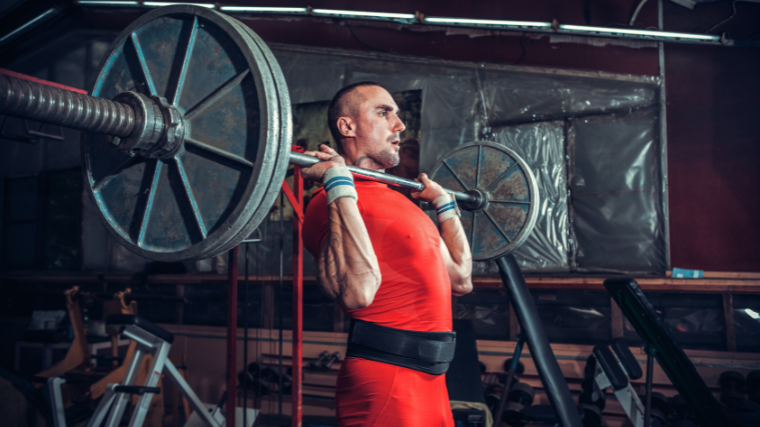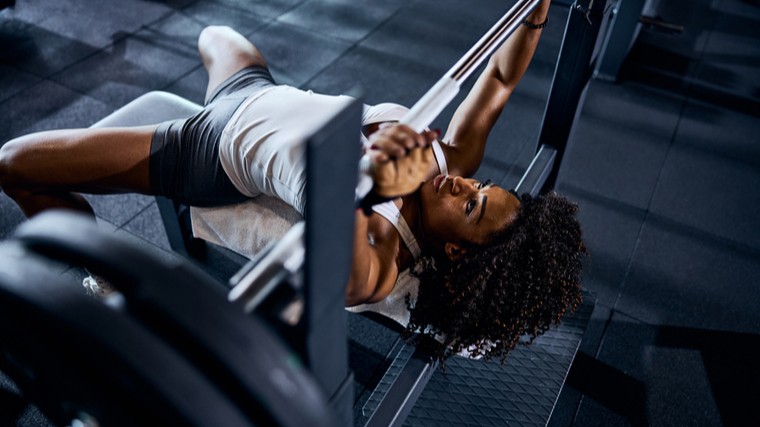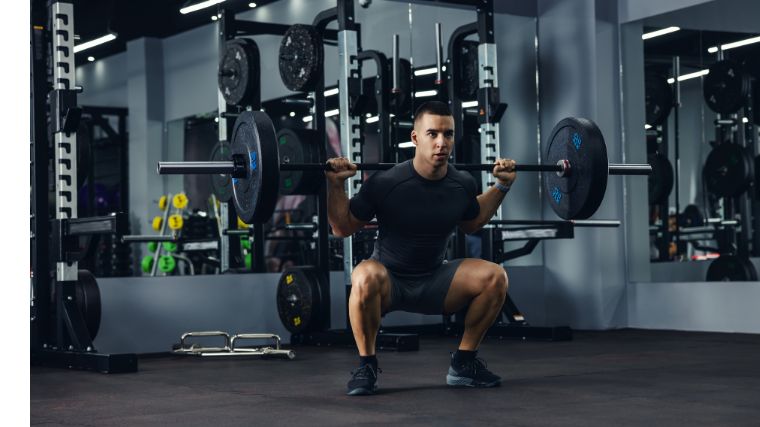Everyone comes to strength sports in their own way. Whether you saw a video online of a weightlifter snatching 400 pounds in the blink of an eye, or witnessed firsthand a powerlifter sinking a back squat ass-to-grass in your local gym, it’s easy to be enamored by the pursuit of strength.
Practicality is another matter. While strength training — as in the intentional practice of powerlifting, Olympic lifting, CrossFit, or strongman — is certainly experiencing a surge of growth, the sports yet present plenty of barriers to entry.

Namely, access to the right facilities. If you want to get good at a strength sport but don’t have access to a gym designed to help you do just that, you have two choices.
You can give up on getting ludicrously strong, or you can work with what you’ve got. This is how to succeed at the latter.
Strength Sport Training in Commercial Gyms
- Weightlifting in Commercial Gyms
- Powerlifting in Commercial Gyms
- Strongman in Commercial Gyms
- CrossFit in Commercial Gyms
Note: If you have a penchant for bodybuilding, you’re in luck. Commercial gyms have just about every piece of equipment you could ask for in your pursuit of maximal muscle growth.
(On the other hand, growing muscle at home can be tricky without the luxuries of a gym.)
How to Do Weightlifting in a Commercial Gym
Weightlifting is the most bare-bones of the major strength sports. Olympic lifters train (and test) only two movements, the snatch and clean & jerk. Both lifts, however, demand that the athlete swiftly take a barbell from the floor to high overhead.
As such, as an aspirant weightlifter, you’ve got a few hurdles to overcome if you want to improve your performance in a public facility.
Limitations
As a weightlifter, two of the biggest issues with practicing your sport in a commercial gym involve equipment access and adhering to the policies of the facility itself.
To train the sport of weightlifting, you really only need three things — a barbell, a set of bumper plates, and a lifting platform to work on (not to mention the right footwear). All of which are staples of a weightlifting-specific gym, but may be hard to find elsewhere.
View this post on Instagram
[Related: Weightlifter Mattie Rogers Back Squats 190KG for Lifetime Personal Record]
(However, some chain gyms are beginning to include platforms and bumpers in their facilities to accommodate interests of a diverse clientele.)
The competition movements and accessory training in weightlifting can sometimes run afoul of a gym’s policies. Many public exercise centers have rules against dropping weights from above a certain height, which particularly affects your ability to train the “classic” versions of the two lifts.
How to Make It Work
It’s not exactly ideal, but you can adjust your Olympic lifting such that it works with the equipment you have access to while also avoiding any unwanted clashes with the staff (or other gymgoers).
- First and foremost, ask the staff at your gym about what kinds of movements are permitted on-site.
- If you aren’t allowed to drop a barbell from shoulder height (or overhead), practice “catching” all your lifts with a re-racking motion instead of dropping the bar.
- In the absence of bumper plates, perform extra work from the hang position or out of a squat rack instead of lifting from the floor.
If your gym doesn’t have bumper plates (or a platform) and forbids you from dropping your barbell, the only thing that’s really off the table is maxing out your snatch or clean & jerk.
You can still perform many standard weightlifting movements such as pulls or power cleans. In addition, you can make easy exercise substitutions such as snatching from the hang instead of the floor.
How to Do Powerlifting in a Commercial Gym
Powerlifters are lucky. The three movements tested in the sport — that’s the squat, bench press, and deadlift — also happen to be phenomenal exercises for everyday fitness enthusiasts.
As a result, most box gyms can accommodate your powerlifting practice, even if doing so isn’t their primary intention.
Limitations
Many of the hurdles involving powerlifting in a commercial gym involve your interactions with the gym’s other patrons. Powerlifting is gritty, intense, and can sometimes be a two-person job, even if you’re the one physically lifting your barbell.
You may need a spotter if you’re attempting a new max on the bench press or squat, which means seeking out a willing participant on the gym floor if you usually fly solo during your sessions.
View this post on Instagram
[Related: Jeff Nippard Debates Bodybuilder Chris Bumstead on the Sumo Deadlift]
That isn’t to say that commercial gyms are a powerlifter’s playground, either. While just about every facility will have barbells and racks for benching and squatting, you might miss out on certain “quality of life” equipment.
Power racks with appropriate safety measures, adjustable bench press hooks, or even circular weight plates for deadlifting comfortably can sometimes be hard to come by.
How to Make It Work
You can run most powerlifting programs just fine in a commercial gym with little worry or wasted time. Still, there’s a good chance you’ll have to make certain accommodations, particularly if you’re an intermediate or advanced athlete.
- Consult the staff ahead of time about your goals. No gym should forbid you from bench pressing, but they may have policies against chalk usage or deadlifting in certain areas.
- Don’t be afraid to befriend other gymgoers who train at the same time as you. You’ll probably need a spotter or hand-off here and there.
- Take note of your training plan and switch out accessory work that you can’t perform in a commercial gym, such as belt squats or dynamic work with bands or chains.
Powerlifting in a commercial gym won’t be a breeze, but it shouldn’t be a pain point either. Your biggest issue might be getting in the zone for a max attempt in a more relaxed environment than that of a meet or strength-specific gym.
How to Do Strongman in a Commercial Gym
It’s obvious enough at a glance, but commercial or box gyms aren’t exactly set up to accommodate strongman training. Strongmen (and women) often train both indoors and outdoors, with a wide variety of implements.
It won’t be impossible, but you’ll need to temper your expectations if you want to make your strongman workouts work in a box gym.
Limitations
Strongman gyms usually come packed to the brim with just about every type of equipment you’ll need for your sport — Atlas stones, yoke frames, specialty deadlift bars, and the like. All of which you’re probably not going to find in most public exercise facilities.
View this post on Instagram
[Related: Strongman Mitchell Hooper — Deadlift Tips From a 1,000-Pound Puller]
Furthermore, strongman training can sometimes take up a lot of space. After all, you’re often tasked with carrying very heavy objects across long distances, and many box gyms will lack the floor space to do these kinds of movements safely and conveniently.
How to Make It Work
While you might not be able to optimally prepare for a strongman competition in a commercial gym, you can work on many of the athletic qualities that translate to your sport.
Upper body strength, pulling prowess, and general conditioning are all things you can improve basically anywhere.
- First and foremost, accept that you’ll have to significantly alter your strongman programming if you’re working out in a commercial gym full-time. (Or, find a strongman gym near you and visit it once a week for event-specific training.)
- Make your training productive by prioritizing weaknesses you might have, like unilateral imbalances or poor mobility.
- Get creative with exercise substitutions so that you’re still training the right motor patterns and technique.
Nothing you can do in a box gym will properly make up for a strongman staple like the log clean & press. However, log work takes a great deal of grip strength and pressing power. You can develop those qualities in a commercial gym just fine.
Further, heavy isometric holds, turf sprints, and all manner of deadlifts will translate pretty well to your strongman performance once you have access to the equipment you need. If you’re diligent about your technique, you should experience noticeable carryover when that time rolls around:
“While the equipment will have to change, your movement patterns will remain the same. Deadlift, overhead press, squat, push, pull and carry. Cover the basics and you’re well on your way to being a successful strength athlete,” says Mitchell Hooper, who ranked 8th during his debut at the 2022 World’s Strongest Man competition.
How to Do CrossFit in a Commercial Gym
If there’s a commercial gym near you, chances are you can find a CrossFit box too. This may not always be the case, though, and you could be stuck having to bang out a WOD in whatever gym you have access to.
Limitations
Many commercial facilities provide most (if not all) of the equipment CrossFitters use in their day-to-day training. From kettlebells to loadable sleds, you can usually find what you need to fit your workout.
You should try to minimize any disruptions to other patrons and consolidate your workout into one set location. You don’t want to have to run end-to-end across the gym to complete a circuit because the equipment you need is hundreds of feet away.
How to Make It Work
You might have some trouble in a box gym if your CrossFit workout calls for heavy Olympic lifting. In such cases, consider subbing those movements out for something less disruptive and more convenient.
Beyond that, some basic planning can save you time and stress once you’ve kicked off your session.
- Assess the layout of the facility you’re in so you know when or if you’ll have to navigate the gym floor to reach certain kinds of equipment.
- If possible, consolidate the equipment you’ll be using into the same space. Try not to borrow too many items at once — no one likes a hoarder.
- Be mindful of where you set up to train. Try to avoid working out in a busy walkway or too close to a valuable piece of equipment such as a squat rack.
CrossFit workouts can sometimes catch a bad rap in commercial gyms. You can avoid making the wrong impression or disrupting other patrons and still crush your workout with a bit of pre-planning and spatial awareness.
Benefits of Training Strength Sports in a Commercial Gym
If training powerlifting, weightlifting, or strongman was best facilitated by a public gym, the strongest athletes in the world would work out there. For the most part, they don’t.
That doesn’t mean you’re not getting any kind of benefit by training in those kinds of gyms. In fact, there’s a silver lining to practicing your strength sport of choice in a general-purpose gym.
Equipment Access
No matter what strength sport you pursue, accessory training is critical to your success. This usually means looking beyond the barbell. What box gyms lack in sport-specific implements, they make up for with versatility.
In a public gym, you’ll generally have access to a variety of tools to work with. A wide array of dumbbells and kettlebells, various plate-loaded machinery, and especially cable stations open up many different opportunities to diversify your programming.
[Read More: How to Bench Press with Dumbbells]
Affordability
This is far from universal, but many strength sport or specialty gyms have high membership rates. After all, independent or warehouse gyms need to furnish their spaces with lots of niche equipment from reputable manufacturers, and those costs add up.

Commercial gyms are usually quite affordable by comparison. If you’re on a budget and can’t afford to join your local barbell gym (or work with one of the coaches there), a commercial gym membership can work in a pinch.
Convenience
Large chain gyms tend to open their doors early and keep them open well into the evening. This makes them fantastic for athletes who need to train in the early morning, or who have inconsistent schedules.
There also tend to be more commercial gyms around than specialty gyms. If you live in a small town or can’t find a facility for your sport, it’s better to train in a public space than not at all.
Drawbacks of Training Strength Sports in a Commercial Gym
Beyond the obvious — not having a dedicated area in which to develop your strength — making do in a commercial gym does come with its own obstacles.
Understanding how your environment can negatively impact your training may help you stave off some of the issues at hand.
Equipment Access
A commercial gym probably won’t have a proper weightlifting bar with smooth spin for you to snatch on. If you’re a powerlifter, you’re unlikely to find a monolift at your local gym either. As a strongman trainee, your prospects are even more grim.
Limited access to the proper training tools is far and away the biggest issue with training at general-purpose gyms, and it’s something you’ll just have to deal with if you choose to work out in one.
Crowds
Gyms can get quite busy depending on the time of day you choose to get your session in. Early to mid-morning, the lunch hour, and early evenings tend to be the most hectic times.
A packed facility can create unwanted noise or distractions that affect your focus. Moreover, from a safety perspective, it can be a bit hazardous to perform a dynamic exercise like the power clean around too many other people.
Distractions
Ambient noise, inconsiderate patrons, or personal trainers working with their clients can all affect your focus while you’re training. However, you can’t wait around for the ideal training environment in a facility that doesn’t cater specifically to your style of lifting.
Some gymgoers may not necessarily understand the importance of keeping their distance while you’re lifting heavy, or they’ll inadvertently walk in front of your eye line while you set up for a big snatch.

Remember that you aren’t entitled to the space in a public gym. Try to be respectful of everyone else, especially if they choose to exercise differently than you.
Time Inefficiency
You might not have an expedited, efficient workout in a commercial gym. Warming up for strength sports takes time — you have to prepare your mind and your body, as well as ramp up to your working sets.
If you’re stuck waiting for a squat rack to open up, you’ll have to get going on your warm-up in the meantime, perhaps in a different area of the facility. Alternatively, a packed-out gym might mean sharing your station with someone else, which can slow you down as well.
If you train at “peak’ times in a box gym, you should expect to move a little more slowly than you would in a powerlifting or weightlifting-specific gym.
Get Strong Anywhere
Lacking access to a sport-specific gym definitely sucks, but it’s no excuse to give up on your pursuit of strength altogether. Some of the strongest lifters in the world do just fine training in “underwhelming” conditions.
After all, your potential with the barbell is about more than whether or not you have air conditioning or a bar with center knurling. It’s determined by how much effort you put in, how diligent you are about your habits outside of the gym, and how important progress is to you. All of which have nothing to do with where you choose to squat or snatch.
Featured Image: Petrenko Andriy / Shutterstock